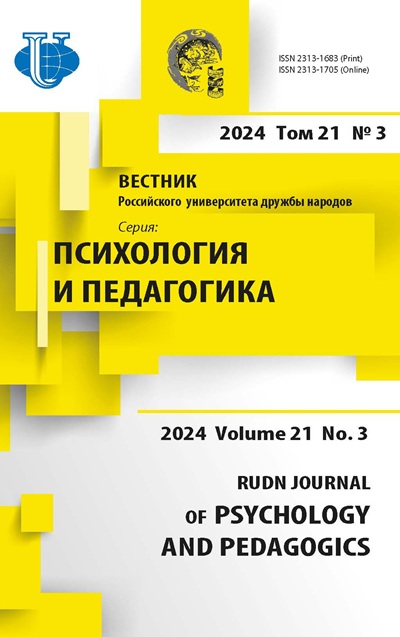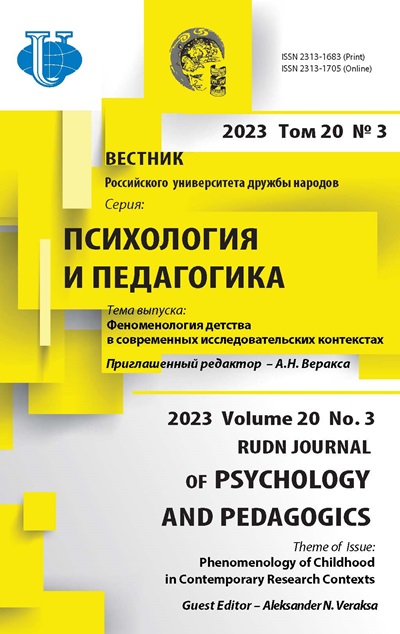Development of Executive Functions in Preschoolers with Different Sibling Positions
- Authors: Almazova O.V.1, Mostinets K.O.1
-
Affiliations:
- Lomonosov Moscow State University
- Issue: Vol 20, No 3 (2023): Phenomenology of Childhood in Contemporary Research Contexts
- Pages: 543-559
- Section: DEVELOPMENT OF SELF-REGULATION: AGE SPECIFICS AND KEY FACTORS
- URL: https://journals.rudn.ru/psychology-pedagogics/article/view/36963
- DOI: https://doi.org/10.22363/2313-1683-2023-20-3-543-559
- EDN: https://elibrary.ru/BNLTMC
Cite item
Full Text
Abstract
The development of the executive functions in older preschoolers largely determines their subsequent successful adaptation and schooling. The purpose of the research is to identify the developmental features of the executive functions in older preschoolers with different sibling positions. The relevance of the theme is due to the growing number of children with insufficient development of self-regulation. The study involved 393 preschoolers attending senior groups of kindergartens: 153 - single children in the family, 99 - oldest, 21 - middle, 110 - youngest children, 10 - twins). The levels of development of the participants’ executive functions were determined using three subtests of the neuropsychological complex NEPSY II (“Inhibition”, “Sentences Repetition” and “Memory for Design”) as well as the “Dimensional Change Card Sort” technique by F. Zelazo. It was revealed that auditory-speech memory is best developed in the oldest children in the family. The results obtained make it possible to suggest a different structure of connections between different components of executive functions in children with different sibling positions. The level and structure of the developed executive functions in the single and youngest children in the family are more similar to each other than in the oldest and single children or in the oldest and youngest ones.
About the authors
Olga V. Almazova
Lomonosov Moscow State University
Author for correspondence.
Email: almaz.arg@gmail.com
ORCID iD: 0000-0001-8852-4076
SPIN-code: 1047-2016
Ph.D. in Psychology, Associate Professor, Department of Developmental Psychology
11 Mokhovaya St, bldg 9, Moscow, 125009, Russian FederationKsenia O. Mostinets
Lomonosov Moscow State University
Email: kseniamostinets@gmail.com
ORCID iD: 0000-0002-4056-1174
SPIN-code: 8886-1893
postgraduate student, Department of Educational Psychology and Pedagogy
11 Mokhovaya St, bldg 9, Moscow, 125009, Russian FederationReferences
- Adler, A. (1998). The education of children. Rostov-on-Don: Feniks Publ. (In Russ.)
- Almazova, O.V. (2015). Attachment to the mother as a factor in the relationship of adult siblings (Ph.D. in Psychology Thesis). Moscow: Lomonosov Moscow State University. (In Russ.)
- Almazova, O.V., & Burmenskaya, G.V. (2015). Attachment to mother as a factor in relationships among adult siblings. Voprosy Psychologii, (4), 15‒25. (In Russ.)
- Almazova, O.V., Buhalenkova, D.A., Veraksa, A.N., & Jakupova, V.A. (2019b). The development of self-regulation in preschoolers. 5–7 years. Toolkit. Moscow: Mozaika-Sintez Publ. (In Russ.)
- Almazova, O.V., Bukhalenkova, D.A., & Veraksa, A.N. (2019a). Assessment of the level of development of executive functions in the senior preschool age. Psychology. Journal of the Higher School of Economics, 16(2), 302‒317. (In Russ.) https://doi.org/10.17323/1813-8918-2019-2-302-317
- Anastasi, A. (1956). Intelligence and family size. Psychological Bulletin, 53(3), 187–209. https://doi.org/10.1037/h0047353
- Barker, J.E., & Munakata, Y. (2015). Developing self‐directed executive functioning: Recent findings and future directions. Mind, Brain, and Education, 9(2), 92–99. https://doi.org/10.1111/mbe.12071
- Bedford, V.H. (1996). Relationships between adult siblings. In A.E. Auhagan & M. von Salisch (Eds.), The Diversity of Human Relationships (pp. 120‒140). Cambridge: Cambridge University Press. https://doi.org/10.1017/cbo9780511586552.007
- Blair, C. (2002). School readiness: Integrating cognition and emotion in a neurobiological conceptualization of children's functioning at school entry. American Psychologist, 57(2), 111–127. https://doi.org/10.1037/0003-066X.57.2.111
- Brody, G.H., & Neubaum-Carlan, E. (2002). Siblings and sibling relationships. In N.J. Salkind (Ed.), Child Development. Macmillan Psychology Reference Series (vol. 1, pp. 363‒365). New York: Macmillan Reference USA.
- Brody, G.H., Kim, S., Murry, V.M., & Brown, A.C. (2003). Longitudinal direct and indirect pathways linking older sibling competence to the development of younger sibling competence. Developmental Psychology, 39(3), 618–628. https://doi.org/10.1037/0012-1649.39.3.618
- Brussoni, M.J. (2000). We are family: Sibling attachment relationships among young adult (Ph.D in Psychology Thesis). Vancouver: The University of British Columbia. https://doi.org/10.14288/1.0089748
- Chertkova, Yu.D., & Kalenova, N.V. (2009). The conception of differences between elder and younger siblings. Psychological Studies, 2(6), 2. (In Russ.) https://doi.org/10.54359/ps.v2i6.965
- Cicirelli, V.G. (1995). Sibling relationships across the life span. Boston, MA: Springer. https://doi.org/10.1007/978-1-4757-6509-0
- Cole, A., & Kerns, K.A. (2001). Perceptions of sibling qualities and activities of early adolescents. Journal of Early Adolescence, 21(2), 204–226. https://doi.org/10.1177/0272431601021002004
- Connidis, I.A. (1992). Life transitions and the adult sibling tie: A qualitative study. Journal of Marriage and the Family, 54(4), 972–982. https://doi.org/10.2307/353176
- Desautels, M. (2008) Sibling relationships (Doctor of Clinical Psychology Thesis). Birmingham: University of Birmingham.
- Diamond, A. (2013). Executive functions. Annual Review of Psychology, 64(1), 135–168. https://doi.org/10.1146/annurev-psych-113011-143750
- Diamond, A., & Lee, K. (2011). Interventions shown to aid executive function development in children 4 to 12 years old. Science, 333(6045), 959–964. https://doi.org/10.1126/science.1204529
- Dumitrashku, T.A. (1996). Family structure and children's cognitive development. Voprosy Psychologii, (2), 104‒112. (In Russ.)
- Dunn, J. (1996). Siblings: The first society. In N. Vanzetti & S. Duck (Eds.), A lifetime of relationships (pp. 105–124). Pacific Grove, CA: Thomson Brooks/Cole Publishing Co.
- Fortuna, K., Roisman, G.I., Haydon, K.C., Groh, A.M., & Holland, A.S. (2011). Attachment states of mind and the quality of young adults' sibling relationships. Developmental Psychology, 47(5), 1366–1373. https://doi.org/10.1037/a0024393
- Homentauskas, G.T. (2006). Family through the eyes of a child: Children and psychological problems in the family. Yekaterinburg: U-Faktorija Publ. (In Russ.)
- Jelkonin, D.B. (2011). Child psychology. Moscow: Akademija Publ. (In Russ.)
- Kang, Н. (2002). The nature of adult sibling relationship: Literature review. Urbana, IL: Children and Family Research Center, School of Social Work, University of Illinois Urbana-Champaign.
- Karabanova, O.A. (2008). Psychology of family relations and the basics of family counseling. Moscow: Gardariki Publ. (In Russ.)
- König, K. (2002). Brothers and sisters: The order of birth in the family. Kaluga: Duhovnoe Poznanie Publ. (In Russ.)
- Korkman, M., Kirk, U., & Kemp, S. (2007). NEPSY II: Administrative manual (2nd ed.). San Antonio, TX: Harcourt Assessment, Psychological Corporation.
- Kuzmina, M. (2000). Siblings, or Cain and Abel in the same apartment. Shkol'nyj Psiholog, (17). (In Russ.) Retrieved April 12, 2023, from https://psy.1sept.ru/article.php?ID=200001710
- Lehto, J.E., Juujärvi, P., Kooistra, L., & Pulkkinen, L. (2003). Dimensions of executive functioning: Evidence from children. British Journal of Developmental Psychology, 21(1), 59–80. https://doi.org/10.1348/026151003321164627
- Lisina, M.I. (2009). Formation of the personality of the child in communication. St. Petersburg: Piter Publ. (In Russ.)
- Lukyanchenko, N.V. (2010). Socio-psychological characteristics of sibling relationships as a significant formation and course of life factor in the mature personality. Psychological Science and Education, 15(1), 31‒40. (In Russ.)
- Miyake, A., Friedman, N.P., Emerson, M.J., Witzki, A.H., Howerter, A., & Wager, T.D. (2000). The unity and diversity of executive functions and their contributions to complex “frontal lobe” tasks: A latent variable analysis. Cognitive Psychology, 41(1), 49–100. https://doi.org/10.1006/cogp.1999.0734
- Neale, C.W. (2003). Perceived sibling compatibility and the effects of personality (MS in Child and Family Development Thesis). Athens, GA: University of Georgia.
- Rufo, M. (2006). Brothers and sisters, the disease of love: Children in the family ‒ growing difficulties. Yekaterinburg: U-Faktorija Publ. (In Russ.)
- Smirnova, E.O. (2015). On the problem of will and self-regulation in culturalhistorical psychology. Cultural-Historical Psychology, 11(3), 9–15. (In Russ.) https://doi.org/10.17759/chp.2015110302
- Smirnova, E.O., & Utrobina, V.G. (1996). On the problem of will and self-regulation in cultural historical psychology. Voprosy Psychologii, (3), 5‒14. (In Russ.)
- Solovieva, Yu., & Quintanar, L. (2015). Qualitative syndrome analysis by neuropsychological assessment in preschoolers with attention deficit disorder with hyperactivity. Psychology in Russia: State of the Art, 8(3), 112‒124. https://doi.org/10.11621/pir.2015.0309
- Sulloway, F.J. (1996). Born to rebel: Birth order, family dynamics, and creative lives. New York: Pantheon Books.
- Teti, D.M. (2001). Retrospect and prospect in the psychological study of sibling relationships. In J.P. McHale & W.S. Grolnick (Eds.), Retrospect and Prospect in the Psychological Study of Families (pp. 213–244). New York: Routledge. https://doi.org/10.4324/9781410604637-15
- Veraksa, A., Almazova, O., Bukhalenkova, D., Bayanova, L., & Popova, R. (2018). Features of executive functions development in Moscow and Kazan preschoolers. In S. Sheridan & N. Veraksa (Eds.), Early Childhood Care and Education. European Proceedings of Social and Behavioural Sciences (vol. 43, pp. 648‒658). Future Academy. https://doi.org/10.15405/epsbs.2018.07.86
- Veraksa, A.N., Almazova, O.V., & Bukhalenkova, D.A. (2020). Executive functions assessment in senior preschool age: A battery of methods. Psikhologicheskii Zhurnal, 41(6), 108‒118. (In Russ.) https://doi.org/10.31857/S020595920012593-8
- Visu-Petra, L., Cheie, L., Benga, O., & Miclea, M. (2012). The structure of executive functions in preschoolers: An investigation using the NEPSY battery. Procedia ‒ Social and Behavioral Sciences, 33, 627–631. https://doi.org/10.1016/j.sbspro.2012.01.197
- Voorpostel, M., & van der Lippe, T. (2007). Support between siblings and between friends: Two worlds apart? Journal of Marriage and Family, 69(5), 1271–1282. https://doi.org/10.1111/j.1741-3737.2007.00446.x
- Vygotskij, L.S. (1984). The collected works. Vol. 4. Child psychology. Moscow: Pedagogika Publ. (In Russ.)
- Walker, A.J., Allen, K.R., & Connidis, I.A. (2005). Theorizing and studying sibling ties in adulthood. In V.L. Bengtson, A.C. Acock, K.R. Allen, P. Dilworth-Anderson & D.M. Klein, (Eds.), Sourcebook of Family Theory and Research (pp. 166‒190). Thousand Oaks, CA: SAGE Publications. https://doi.org/10.4135/9781412990172.d36
- White, L.K., & Riedmann, A. (1992). When the Brady Bunch grows up: Step/halfand full sibling relationships in adulthood. Journal of Marriage and the Family, 54(1), 197–208. https://doi.org/10.2307/353287
- Willoughby, M.T., Kupersmidt, J.B., & Voegler-Lee, M.E. (2012). Is preschool executive function causally related to academic achievement? Child Neuropsychology, 18(1), 79–91. https://doi.org/10.1080/09297049.2011.578572
- Yeniad, N., Malda, M., Mesman, J., van IJzendoorn, M.H., & Pieper, S. (2013). Shifting ability predicts math and reading performance in children: A meta-analytical study. Learning and Individual Differences, 23, 1–9. https://doi.org/10.1016/j.lindif.2012.10.004
- Zelazo, P.D. (2006). The Dimensional Change Card Sort (DCCS): A method of assessing executive function in children. Nature Protocols, 1(1), 297–301. https://doi.org/10.1038/nprot.2006.46
- Zyrianova, N.M. (2008). Early sibling investigations. Psychological Studies, 1(2), 10. (In Russ.) https://doi.org/10.54359/ps.v1i2.1028
















